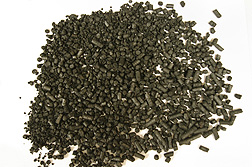This page has been archived and is being provided for reference purposes only. The page is no longer being updated, and therefore, links on the page may be invalid.
| Read the magazine story to find out more. |
|
|
|
|
Using Biochar to Boost Soil Moisture
By Ann PerryNovember 8, 2011
Scientists at the U.S. Department of Agriculture (USDA) are leading the way in learning more about "biochar," the charred biomass created from wood, other plant material, and manure.
The studies by Agricultural Research Service (ARS) scientists at laboratories across the country support the USDA priorities of promoting international food security and responding to global climate change. ARS is USDA's chief intramural scientific research agency.
Soil scientist Jeff Novak at the ARS Coastal Plains Soil, Water and Plant Research Center in Florence, S.C., is coordinating the multi-location effort. In one project, he led a laboratory study to see if different biochars could improve the sandy soils found on the Carolina coastal plain, and Pacific Northwest silt loam soils derived from volcanic ash.
Novak's team used peanut hulls, pecan shells, poultry litter, switchgrass and hardwood waste products to produce nine different types of biochars. All the feedstocks were pyrolysed at two different temperatures to produce the biochars. Pyrolysis is a process of chemical decomposition that results from rapid heating of the raw feedstocks in the absence of oxygen. Then the biochars were mixed into one type of sandy soil and two silt loam soils at the rate of about 20 tons per acre.
After four months, the team found that biochars produced from switchgrass and hardwoods increased soil moisture storage in all three soils. They saw the greatest increase in soils amended with switchgrass biochar produced via high-temperature pyrolysis—almost 3 to 6 percent higher than a control soil sample.
Biochars produced at higher temperatures also increased soil pH levels, and biochar made from poultry litter greatly increased soil levels of available phosphorus and sodium. The scientists also calculated that the switchgrass biochar amendments could extend the window of soil water availability by 1.0 to 3.6 days for a soybean crop in Florence, and could increase soil water availability for crops grown in Pacific Northwest silt loam soils by 0.4 to 2.5 days.
Given their results, the team believes that agricultural producers could someday select feedstocks and pyrolysis processes to make "designer" biochars with characteristics that target specific deficiencies in soil types.
Results from this study were published in Annals of Environmental Science and in the Journal of Environmental Quality.
Read more about this work in the November/December 2011 issue of Agricultural Research magazine.

